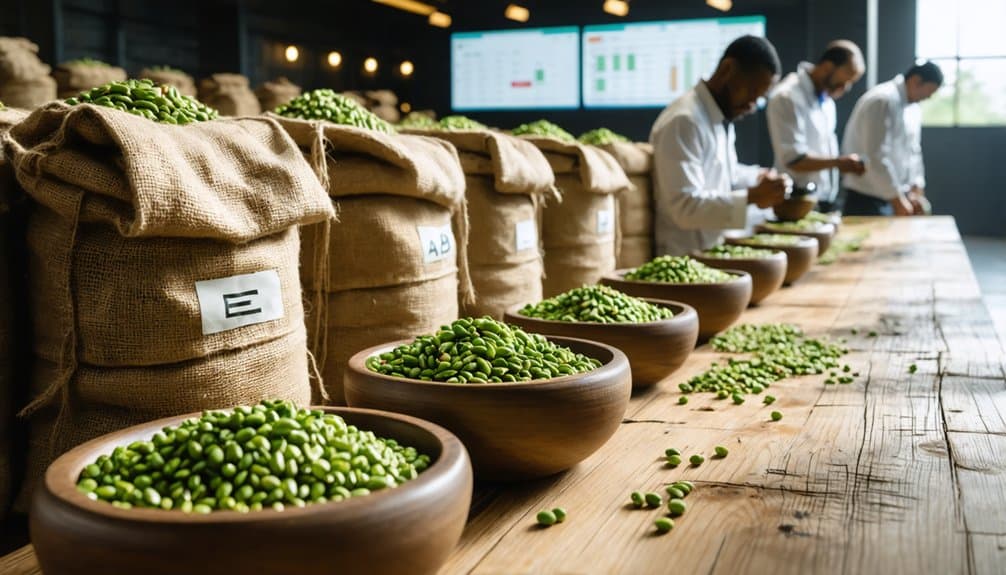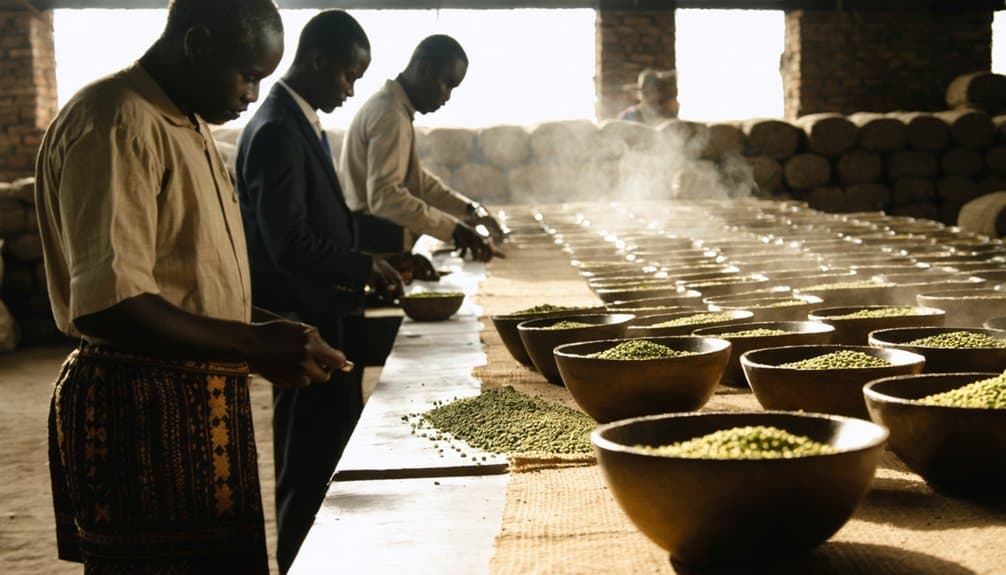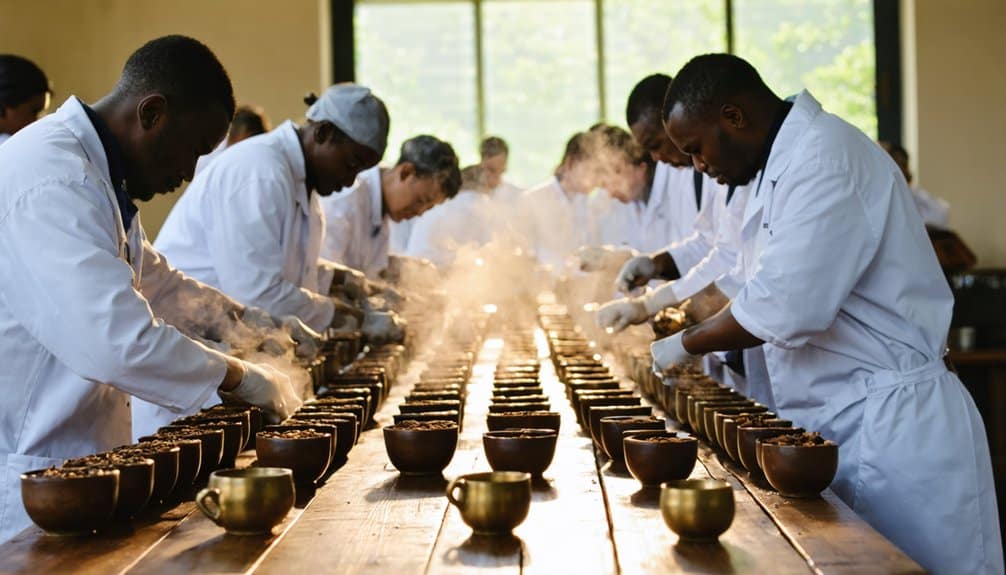To navigate Kenya’s coffee auction marketplace, you’ll need to master the size-based grading system (E, AA, AB, PB, C) and auction day protocols.
Work with NCE-registered marketing agents who have proven track records and significant market share.
Understand both auction and Second Window participation strategies for peak returns.
Guarantee strict quality control through licensed sampling agents at every stage.
These fundamentals will reveal your success in Kenya’s sophisticated coffee trading ecosystem.
Key Takeaways
- Partner with an NCE-registered marketing agent who has proven experience and significant market share to access auction opportunities.
- Collect and analyze quality-verified samples from licensed warehouses before participating in auctions.
- Track weekly auction prices and maintain dollar-based transactions through approved bank accounts for financial compliance.
- Focus on consistent bean sizing and grading standards to ensure uniform quality across purchased coffee lots.
- Establish a balanced strategy between auction participation and Second Window direct trade for optimal market access.
Mastering Kenya’s Coffee Grade Classifications

While Kenya’s coffee grading system primarily focuses on bean size, understanding these classifications is essential for successful auction participation.
You’ll encounter E (Elephant) beans as the largest grade, followed by AA beans measuring over 7.2mm in diameter. AB grades come next, with PB (Peaberry) offering unique characteristics.
C grades represent smaller beans. Grown above 6,600 feet, Kenya AA beans are among the country’s most prized exports.
When you’re bidding, keep in mind that size classification doesn’t determine quality – each grade contains different quality classes.
You’ll want to focus on consistency in roasting, as comparably-sized beans roast more uniformly.
Monitor how recent regulation changes affect sampling access and quality assessment timelines.
Understanding Auction Day Procedures and Timing
Before entering Kenya’s coffee auction marketplace, you’ll need to master the structured timing and procedural requirements that govern trading sessions.
You’ll find auctions scheduled within five working days of the sale date, as specified in the sales catalogue.
Clean coffee grading must be verified at licensed warehouses before any trading can commence.
As a trader, you’re required to collect offer samples from the sample room after paying the appropriate fee.
All trading must be conducted in US dollars through licensed participants only.
When you’re ready to execute trades, you’ll operate through the auction system, with all proceeds flowing through an Authority-approved settlement bank’s segregated account.
Working With Marketing Agents Effectively

Although maneuvering through Kenya’s coffee auction marketplace can be complex, partnering with the right marketing agent is crucial for your success.
Select an NCE-registered agent with proven experience and substantial market share, like Sangana Commodities, which commands over 13% of auctioned coffees.
Professional agents like SMS focus on providing farm management consultancy and agronomy support services.
Your ideal agent should offer thorough services including direct sales, pre-financing options, and market insights. Maintain clear communication and build trust through regular feedback.
Look for agents who demonstrate strong client retention, consistent price achievement, and regulatory compliance.
When evaluating potential partners, prioritize those providing transparent data and long-term commitment to your growth.
Leveraging Both Auction and Second Window Options
Since Kenya’s coffee market operates through dual channels, you’ll need a strategic approach to optimize returns from both the NCE auction system and Second Window opportunities.
Consider building direct trade relationships through the Second Window while maintaining auction participation to diversify your sourcing channels.
Track auction prices weekly to benchmark your Second Window negotiations, and partner with reliable marketing agents who understand both systems.
For premium lots, utilize the Second Window’s traceability benefits and faster payments. Working with the Capital Markets Authority provides additional oversight and security for your trading activities.
However, don’t neglect the auction’s consistent volume and established grading standards, especially when sourcing standard grades or filling immediate supply gaps.
Navigating Quality Control and Sample Assessment

When entering Kenya’s coffee market, you’ll need to master its extensive quality control system, which combines strict agronomic schedules with multi-stage sampling protocols.
Your success depends on understanding both sampling requirements and grading standards.
Work closely with licensed sampling agents who’ll assess your coffee through multiple stages:
| Process Stage | Quality Focus |
|---|---|
| Pre-Milling | Cherry selection, moisture content |
| Milling | Size grading, density sorting |
| Post-Milling | Cup quality, defect analysis |
Most sales occur through the Nairobi Coffee Exchange, where licensed agents represent farmers and organize coffee lots for auction.
FAQs
How Do International Currency Fluctuations Affect Bidding Strategies at Kenya’s Coffee Auctions?
You’ll need to monitor exchange rates closely, as currency fluctuations impact your bidding power at Kenya’s auctions. A weaker shilling means higher local returns but increased production costs.
What Happens to Unsold Coffee Lots After the Weekly Auctions?
With 60% of stocks facing potential passive window relegation, you’ll see unsold lots recirculated twice in fresh auctions. If they don’t sell, they’re moved to low-price passive trading windows.
Can Small-Scale Farmers Form Consortiums to Participate Directly in Auctions?
Yes, you can form consortiums through cooperatives or farmer groups to participate in auctions, but you’ll need to meet legal requirements and register with licensed marketing agents initially.
Are There Seasonal Patterns in Auction Prices Throughout the Year?
You’ll see highest prices during peak harvest (November-April), with fluctuations based on quality, rainfall patterns, and bean development. Weekly auctions reflect immediate supply-demand dynamics and C-market influences.
How Do Transportation Logistics From Rural Areas Affect Auction Participation Costs?
With rural logistics costs consuming up to 40% of auction revenues, you’ll need to optimize transport through consolidation services, temperature-controlled shipping, and partnering with global logistics providers to maintain profitability.
The Bottom Line
Kenya’s coffee auction marketplace isn’t just a trading floor – it’s your gateway to some of the world’s most sought-after beans.
You’ll need to master the intricate dance of grades, timing, and relationships to succeed here.
Whether you’re bidding through the historic auction system or exploring second window opportunities, your success hinges on precise quality assessment and strategic market positioning.
Let your cupping expertise guide your investments.
